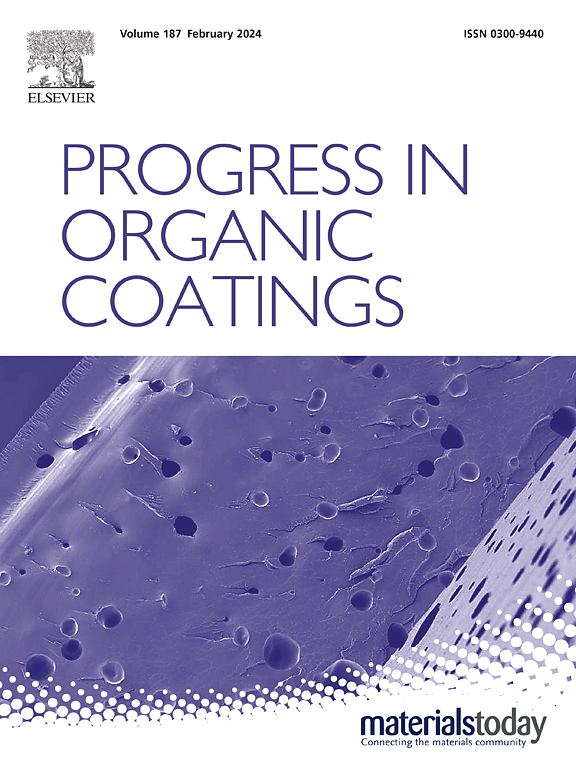Synthesis of silane-functionalized polyols from natural rubber by thiol-ene click reaction and preparation of waterborne polyurethane films
IF 7.3
2区 材料科学
Q1 CHEMISTRY, APPLIED
引用次数: 0
Abstract
A new bio-polyol silane-functionalized hydroxyl telechelic natural rubber (SHTNR) was successfully synthesized from hydroxyl telechelic natural rubber (HTNR) with molecular weight 3500 g.mol−1 using (3-mercaptopropyl) trimethoxysilane (MPTMS) and Darocur1173 as photoinitiator, via thiol-ene click reaction. The photoinitiator content, reaction time, and the MPTMS content for the SHTNR synthesis were studied. The chemical structure of SHTNR was confirmed by FTIR, 1H NMR, 13C NMR, and 29Si NMR spectroscopy. The kinetics of thiol-ene click reactions were monitored by 1H NMR. The percentage of double bond conversion and the molecular weight of SHTNR increased with photoinitiator content, with reaction time and depended on MPTMS amount. Waterborne polyurethane (WPU) was synthesized from HTNR by emulsion polymerization. In addition, a series of SHTNR were used as a functional bio-polyol in the preparation of hybrid waterborne polyurethane (HWPU) for comparison with WPU, giving stable dispersions and a total solid content of about 15 %. The particle size and the negative zeta potential values increased with the degree of silane functionalization in the HWPU, with a shelf-life of less than 3 months. The shape and morphology of WPU and a series of HWPU particles were observed by Transmission Electron Microscopy, an average diameter of 180 nm was measured. The HWPU films exhibited better tensile strength and thermal stability than WPU ones. Moreover, the activation energy of the degradation increased with increasing degree of silane functionalization in HWPU film. In addition, the incorporation of silanol group in HWPU films was confirmed by SEM-EDX spectroscopy. The experimental results demonstrated the benefit of using natural rubber from renewable resources and thiol-ene reaction to form a new bio-polyol to produce hybrid polyurethane dispersions that could serve as an alternative in green coating applications.

以天然橡胶为原料,用巯基键合反应合成硅烷功能化多元醇及水性聚氨酯薄膜的制备
以羟基远旋天然橡胶(HTNR)为原料,以(3-巯基丙基)三甲氧基硅烷(MPTMS)和Darocur1173为光引发剂,通过巯基点击反应,成功合成了分子量为3500 g.mol - 1的生物多元醇硅烷功能化羟基远旋天然橡胶(SHTNR)。研究了合成SHTNR的光引发剂含量、反应时间和MPTMS含量。通过FTIR、1H NMR、13C NMR、29Si NMR等方法对其化学结构进行了确证。采用1H NMR对巯基咔嗒反应动力学进行了监测。双键转化率和SHTNR的分子量随光引发剂含量、反应时间和MPTMS用量的增加而增加。以HTNR为原料,采用乳液聚合法制备了水性聚氨酯(WPU)。此外,将一系列SHTNR作为功能性生物多元醇用于制备混合水性聚氨酯(HWPU),并与WPU进行比较,得到了稳定的分散体,总固含量约为15%。随着硅烷功能化程度的增加,HWPU的粒径和负zeta电位值增加,保质期小于3个月。通过透射电镜观察了WPU和一系列HWPU颗粒的形状和形态,平均直径为180 nm。HWPU薄膜的拉伸强度和热稳定性均优于WPU薄膜。此外,随着HWPU膜中硅烷功能化程度的增加,降解活化能也随之增加。此外,通过SEM-EDX谱分析证实了HWPU膜中存在硅烷醇基团。实验结果表明,利用可再生资源中的天然橡胶和硫醇反应形成一种新的生物多元醇来生产混合聚氨酯分散体的好处,可以作为绿色涂料的替代品。
本文章由计算机程序翻译,如有差异,请以英文原文为准。
求助全文
约1分钟内获得全文
求助全文
来源期刊

Progress in Organic Coatings
工程技术-材料科学:膜
CiteScore
11.40
自引率
15.20%
发文量
577
审稿时长
48 days
期刊介绍:
The aim of this international journal is to analyse and publicise the progress and current state of knowledge in the field of organic coatings and related materials. The Editors and the Editorial Board members will solicit both review and research papers from academic and industrial scientists who are actively engaged in research and development or, in the case of review papers, have extensive experience in the subject to be reviewed. Unsolicited manuscripts will be accepted if they meet the journal''s requirements. The journal publishes papers dealing with such subjects as:
• Chemical, physical and technological properties of organic coatings and related materials
• Problems and methods of preparation, manufacture and application of these materials
• Performance, testing and analysis.
 求助内容:
求助内容: 应助结果提醒方式:
应助结果提醒方式:


